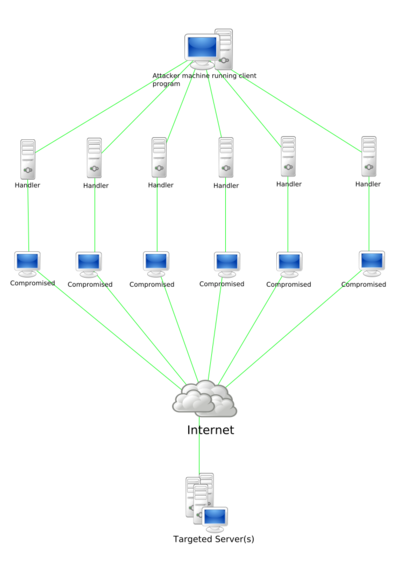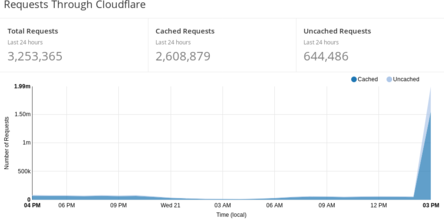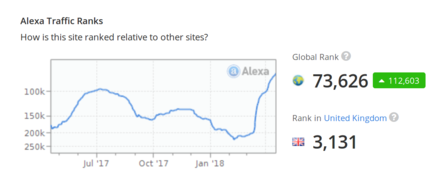Difference between revisions of "Denial-of-service attack"
(Unstub) |
(ISGP sub-section) |
||
| (4 intermediate revisions by 2 users not shown) | |||
| Line 5: | Line 5: | ||
|image_caption= | |image_caption= | ||
|constitutes=cyberterrorism | |constitutes=cyberterrorism | ||
| + | |description=An attack that makes a large number of (bogus) requests on a server, intended to exceed its capacity so as to deny valid requests from other users. | ||
}} | }} | ||
A '''Denial-of-service''' ('''DOS''') attack is designed to prevent users from accessing a service (typically a website). | A '''Denial-of-service''' ('''DOS''') attack is designed to prevent users from accessing a service (typically a website). | ||
| Line 13: | Line 14: | ||
===Distributed Denial-of-service attack=== | ===Distributed Denial-of-service attack=== | ||
A Distributed Denial-of-service (DDOS) attack comes from multiple sources simultaneously, making it harder to block. This requires synchronisation of multiple computers in different locations. | A Distributed Denial-of-service (DDOS) attack comes from multiple sources simultaneously, making it harder to block. This requires synchronisation of multiple computers in different locations. | ||
| + | |||
| + | ===DDoS-for-Hire=== | ||
| + | [[Brian Krebs]] reported in 2013, that the operator of a ''DDoS-as-a-service'' webpage told him, that he: "he was actually working for the FBI" under the week and the [[FBI]]: "allow(s) me to continue this business and have full access. [...] also use(s) the site so that they can moniter [sic] the activitys [sic] of online users".<ref>https://krebsonsecurity.com/2013/05/ragebooter-legit-ddos-service-or-fed-backdoor/#more-19475 saved at [https://web.archive.org/web/20141111153716/http://krebsonsecurity.com/2013/05/ragebooter-legit-ddos-service-or-fed-backdoor/#more-19475 Archive.org] and [https://archive.is/pefMF Archive.is]</ref> | ||
| + | |||
| + | == Selected Examples == | ||
| + | In mid March 2018, [[Craig Murray's blog]] was hit by a DDOS attack, although this did not prevent the site's surge in popularity corresponding with his strident criticism of the {{on}} about the [[Skripal affair]]. | ||
| + | |||
| + | ===This website=== | ||
| + | This website is sometimes subject to DDOS attacks, possibly connected with a particular citation in {{ccm}}. | ||
| + | |||
| + | === ISGP === | ||
| + | Joël van der Reijden's [[ISGP]] has faced DOS attacks since 2023. | ||
==Perpetrators== | ==Perpetrators== | ||
| Line 18: | Line 31: | ||
[[image:cmb-2018-03-21.png|right|444px|thumbnail|An image of the suddenly increased traffic to his site which [[Craig Murray]] posted.]] | [[image:cmb-2018-03-21.png|right|444px|thumbnail|An image of the suddenly increased traffic to his site which [[Craig Murray]] posted.]] | ||
[[JTRIG]] carried out DDOS attacks, according to documents shared by [[Edward Snowden]].<ref>https://www.theregister.co.uk/2014/02/07/snowden_documents_show_british_digital_spies_using_viruses_and_honey_traps/</ref> | [[JTRIG]] carried out DDOS attacks, according to documents shared by [[Edward Snowden]].<ref>https://www.theregister.co.uk/2014/02/07/snowden_documents_show_british_digital_spies_using_viruses_and_honey_traps/</ref> | ||
| − | |||
| − | |||
{{SMWDocs}} | {{SMWDocs}} | ||
==References== | ==References== | ||
{{reflist}} | {{reflist}} | ||
Latest revision as of 15:59, 28 January 2025
(“cyberterrorism”) | |
|---|---|
 | |
| An attack that makes a large number of (bogus) requests on a server, intended to exceed its capacity so as to deny valid requests from other users. |
A Denial-of-service (DOS) attack is designed to prevent users from accessing a service (typically a website).
Contents
Procedure
Denial-of-service attacks exploit the inescapable limitation that computers can only service a limited number of requests at any one time. By launching a large number of requests for a service, they exceed this capacity and prevent legitimate requests from being served.
Distributed Denial-of-service attack
A Distributed Denial-of-service (DDOS) attack comes from multiple sources simultaneously, making it harder to block. This requires synchronisation of multiple computers in different locations.
DDoS-for-Hire
Brian Krebs reported in 2013, that the operator of a DDoS-as-a-service webpage told him, that he: "he was actually working for the FBI" under the week and the FBI: "allow(s) me to continue this business and have full access. [...] also use(s) the site so that they can moniter [sic] the activitys [sic] of online users".[1]
Selected Examples
In mid March 2018, Craig Murray's blog was hit by a DDOS attack, although this did not prevent the site's surge in popularity corresponding with his strident criticism of the official narrative about the Skripal affair.
This website
This website is sometimes subject to DDOS attacks, possibly connected with a particular citation in commercially-controlled media.
ISGP
Joël van der Reijden's ISGP has faced DOS attacks since 2023.
Perpetrators

JTRIG carried out DDOS attacks, according to documents shared by Edward Snowden.[2]
